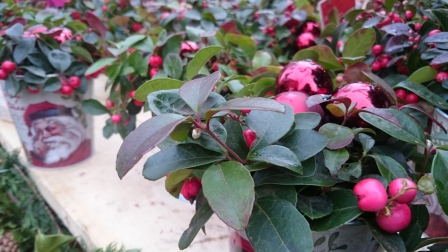#AdventBotany 2016 Day 13: A very festive and minty Christmas with Wintergreen
Guest blog by: Sophie Mogg (with images and introduction provided by Rachel Webster)
It’s always a joy to see something growing through these dark and dreary winter months. With glossy, green leaves, little cream bell-like flowers and big, red berries that start to appear as the snow melts, today’s plant, Gaultheria procumbens, is a very popular choice for baskets and containers. The name of this plant originates from Pehr Kalm, a Swedish explorer who named this plant after his good friend, Dr. Hugues Gaultier who expressed huge enthusiasm for the plant’s potential for tea.

 Gaultheria procumbens goes by many common names such as the Checkerberry, Mountain Tea or my particular favourite la Petit te du bois meaning “the little tea of the woods”. The “tea” part of these common names refers to the fact that the leaves can indeed be brewed for tea however unlike that of Camellia sinensis, the leaves must be left to ferment in order to produce a distinct flavour. Drinkers of this mountain tea suggest that you place several leaves in a jar that can be sealed with boiling water and then cover said jar with a cloth or tea towel. The leaves must then be left to ferment for roughly 3 days in a warm environment, or at least till you can see small bubbles appearing. The liquid can be drained from the jar and stored, being diluted and warmed when required. The left over leaves are then dried and can be used again to make a more delicate flavoured tea. The leaves are evergreen and so can be harvested all year round to produce tea however it is suggested that you only take one or two leaves from each stem.
Gaultheria procumbens goes by many common names such as the Checkerberry, Mountain Tea or my particular favourite la Petit te du bois meaning “the little tea of the woods”. The “tea” part of these common names refers to the fact that the leaves can indeed be brewed for tea however unlike that of Camellia sinensis, the leaves must be left to ferment in order to produce a distinct flavour. Drinkers of this mountain tea suggest that you place several leaves in a jar that can be sealed with boiling water and then cover said jar with a cloth or tea towel. The leaves must then be left to ferment for roughly 3 days in a warm environment, or at least till you can see small bubbles appearing. The liquid can be drained from the jar and stored, being diluted and warmed when required. The left over leaves are then dried and can be used again to make a more delicate flavoured tea. The leaves are evergreen and so can be harvested all year round to produce tea however it is suggested that you only take one or two leaves from each stem.
The essential oils of the leaves, known as oil of wintergree n, contains methyl salicylate and relative of aspirin and is known to act as a natural painkiller however those who are allergic to aspirin should avoid Gaultheria procumbens.
n, contains methyl salicylate and relative of aspirin and is known to act as a natural painkiller however those who are allergic to aspirin should avoid Gaultheria procumbens.
The small berries produced by Gaultheria procumbens is often referred to as “teaberries” and these are also edible with a mild minty wintergreen taste. The unripe berries are a pale green-white colour but soon ripen to a beautiful rosy red with a star-shaped depression on the bottom. They can be eaten raw or cooked to produce pies, jams or jellies.
For a very festive and minty Christmas why not try wintergreen wine – a recipe using either the leaves or the berries can be found here. Recipes for wintergreen ice cream and muffins.
This entry was posted in #AdventBotany, Specimen of the Day and tagged #AdventBotany, Christmas, Gaultheria procumbens, Hebarium sheet, Manchester, Medica, museum, Wintergreen.
December 13, 2016 at 4:29 pm
[…] Read more at Herbology Manchester. […]
December 17, 2016 at 2:58 pm
[…] Read more at Herbology Manchester. […]
January 12, 2017 at 10:33 am
[…] be made from. In a more recent blog post you have seen that tea can be made from winter green (Gaultheria procumbens) and the same can be said for a lot of plants. Today I will be venturing into the world […]